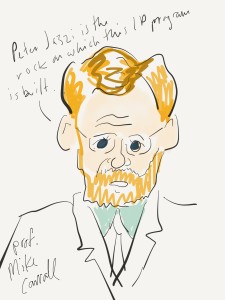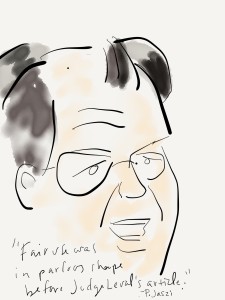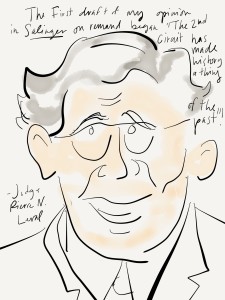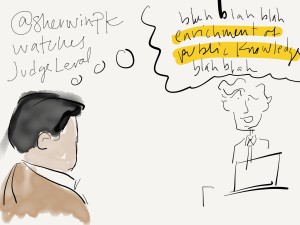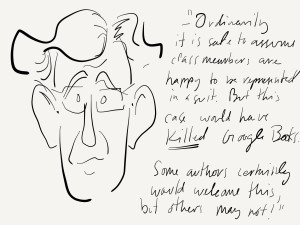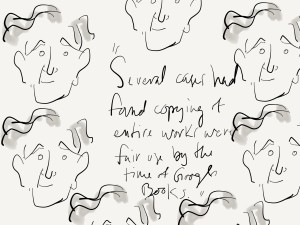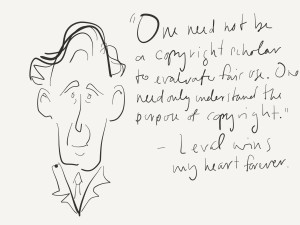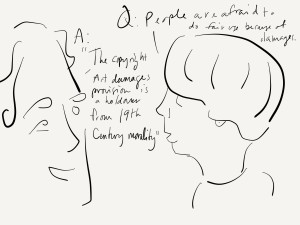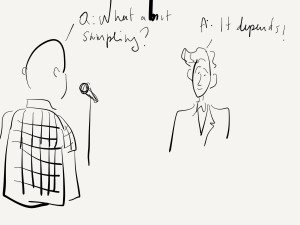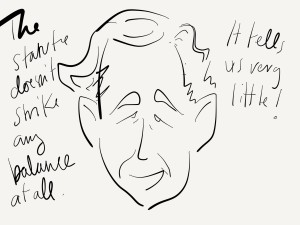 [Reposted from TechDirt, Link] Last Thursday, Judge Pierre N. Leval, a renowned fair use scholar and judge on the Second Circuit Court of Appeals in New York, delivered the Fourth Annual Peter A. Jaszi Distinguished Lecture on Intellectual Property (you can watch the recording at that link) at the law school where I teach, the American University Washington College of Law (whew). “Lecture” doesn’t really do it justice, though; Leval may have spoken in front of a lectern at a law school, but what he said was hardly dry or academic. Instead, it was a bravura exercise in storytelling, which is fitting, as storytelling and narrative are some of Peter Jaszi’s favorite subjects, second only to fair use.
[Reposted from TechDirt, Link] Last Thursday, Judge Pierre N. Leval, a renowned fair use scholar and judge on the Second Circuit Court of Appeals in New York, delivered the Fourth Annual Peter A. Jaszi Distinguished Lecture on Intellectual Property (you can watch the recording at that link) at the law school where I teach, the American University Washington College of Law (whew). “Lecture” doesn’t really do it justice, though; Leval may have spoken in front of a lectern at a law school, but what he said was hardly dry or academic. Instead, it was a bravura exercise in storytelling, which is fitting, as storytelling and narrative are some of Peter Jaszi’s favorite subjects, second only to fair use.
Judge Leval recently authored the landmark opinion in Authors Guild v. Google, vindicating Google’s massive digitization program which, in collaboration with research libraries all over the country, has made more than 20 million books full-text searchable and available for data-mining with the very cool Ngram Viewer. The opinion was the apotheosis of 25 years of fair use case law set in motion by Judge Leval himself in a 1990 law review article entitled “Toward a Fair Use Standard.” Now here was the man himself, ready to talk about fair use in the digital age, and in honor of transformative use’s most vociferous defender.
Judge Leval’s lecture, like his opinion, told the story of fair use, from “rudderless” meandering after codification in 1976, to a pair of half-baked Supreme Court opinions in the 1980s, and, finally, to salvation in Justice Souter’s opinion in Campbell v. Acuff-Rose, which was (though Judge Leval humbly never said so) largely a judicial endorsement of the analysis published a few years earlier in Leval’s article. (As Public Knowledge’s Raza Panjwani pointed out, the article is cited 16 times in the opinion.)
I’m a law professor, and a fair use obsessive. I’ve written a lot about this stuff in scholarly and non-scholarly contexts. So, I should have been listening to every single word Judge Leval said, parsing it like the Talmud for meaning and guidance. Instead, I got out my iPad and made cartoons. I’m sure I’ll be re-watching the lecture many times for all that nuance, but the chance to live-tweet with sketches of the man himself was once-in-a-lifetime. So, I present for you below the broad outlines of the story of fair use that Judge Leval told last night, together with some of my drawings from the event.
Introductions: Peter Jaszi the rock, Judge Leval the redeemer
In his introductory remarks, Professor Michael Carroll, the director of AU’s IP program, paid tribute to the namesake of the lecture, Peter Jaszi. Peter has been a mentor to many, many copyright lawyers and scholars in this town (including me!), and, as Michael said, for decades Peter was a one-man IP program at AU:
For his part, Peter Jaszi highlighted the transformative (ha!) impact that Judge Leval has had on the doctrine:
Act I: In which Judge Leval’s fair use opinions are reversed over and over for dumb reasons and he considers mouthing off to the Second Circuit
Judge Leval began his talk the same way he began his landmark article, with a kind of mea culpa, but really an indictment of the whole judiciary and its treatment of fair use. Early in his judicial career, Leval (then a district court judge) had been reversed by the Second Circuit on appeal in a series of cases involving unpublished works excerpted in scholarly and critical books. The rationale for the reversals—that unpublished works can never be the subject of fair use because of the so-called “right of first publication”—struck Leval (and most of the rest of the world) as bizarre. In particular, it seemed like a major problem for people who want to write about history, which often involves quoting unpublished letters and other primary materials. How, other than to quote him, can one credibly show (as the defendant in one of these cases sought to do) that L. Ron Hubbard wrote awful, retrograde garbage, not gospel? But unpublished works, the 2nd Circuit said, were off-limits. When he was instructed by the Second Circuit to rehear the case with that silly per se rule in mind, Judge Leval was sorely tempted to take a swipe at their stupid rule:
But, he said, he decided to cut that line, “because nobody likes a wise-ass.” “It was exhilarating to be on the cutting edge of the law, even though the role assigned to me was that of the salami,” he added.
Act II: In which the Supreme Court mucks things up even more, despite reaching the right outcomes
Next, Leval described how, in its two big fair use cases in the 1980s, the Supreme Court reached the right conclusions but dropped a series of silly and misleading duds into the doctrine in the process. First, in *Sony v. Universal*, the court rightly found that of course making and selling VCRs was not somehow a massive infringement enterprise:
In the process of exonerating the technology, though, the court decided to reach out and opine on the question of whether it is fair use to tape television shows in order to watch them later. And, in the process of making this (Leval seemed to say unnecessary) determination, the Court opined that “commercial uses are presumptively unfair.” What? This was kind of a shock, since several core fair uses, including news reporting and criticism, are often done in the context of a commercial enterprise. The presumption proceeded to wreak havoc for almost a decade before *Campbell* came along to correct it.
Then, in *Harper & Row v. Nation*, the Court decided (rightly, Leval figured) that the Nation had not made fair use of about 300 words from Gerald Ford’s forthcoming autobiography by excerpting it in their magazine. In addition to the legitimate question of the market prerogatives of Harper & Row regarding publication of basically the only interesting stuff in their book, the Court considered and condemned the fact that the Nation had come by its copy of the book by means of a purloined manuscript. “Purloining is baaaaaad!” Judge Leval intoned in a mock condemnation, and “‘Fair use,’ Justice O’Connor wrote for the majority (citing an earlier case), ‘presupposes good faith and fair dealing.’”
Hogwash, said Judge Leval. “If conduct does not break any law, or violate anyone’s rights, it does not become illegal or actionable because the actor had an evil heart.” Imagine the facts had been different, Judge Leval suggested. What if the Nation had “purloined” a document that proved Nixon had bribed Ford with millions of dollars for the pardon? Surely the purloining would not undermine the fair use of this clearly newsworthy information.
Once Judge Leval got going about the purposes of copyright, it became clear that he had arrived at a particular phrase to summarize that purpose: “the enrichment of public knowledge.” He had used it several times in the Google Books opinion, but it really tripped off his tongue during the talk. I guarantee he said it at least ten times:
Act III: In which *Campbell* saves fair use, and Google Books follows logically therefrom
Judge Leval passed humbly over what happened next, but I won’t: his article, “Toward a Fair Use Standard,” was published in the Harvard Law Review. That article contains, at greater length and with plenty of caselaw, the very same story of fair use that had so far occupied the talk: First there was the fair use doctrine, which was kind of a mess; then there were Judge Leval’s opinions, which were not crazy but also mostly “from the gut”; then there was this silly rule about unpublished works; then there were these two SCOTUS cases that had really made a mess of things, even if the outcomes might have been right. Judge Leval proposed a solution in his article: to decide fair use cases in a coherent way, courts should focus on whether a use is justified by serving the underlying public interest goals of copyright, namely (drumroll) the enrichment of public knowledge, without serving as a market substitute for the works they use. When a use does this (enriching PK and not substituting for the original), Leval proposes we call it “transformative.”
Leval skipped right past the fact that he had personally proposed the solution, instead heaping voluminous praise on Judge Souter, who wrote the majority opinion in Campbell v. Acuff-Rose, adopting Leval’s framework almost completely. This brought to an end “250 years of rudderless drift” in fair use case law. In that 1994 case, the Court reversed a lower court’s ruling that 2 Live Crew had infringed on the copyright in Roy Orbison’s “Oh, Pretty Woman” by using the core hook and melody of the song in its rap song “Pretty Woman,” which was a decidedly raunchier ode to a woman walking down the street. The lower court had applied Sony and found this commercial use to be presumptively unfair, a presumption that the Crew did not overcome. But the SCOTUS majority in Campbell noted that the new song was very different from the original in terms of its meaning, and indeed could be seen (though this is debatable) as a parody of the original, and this was precisely the kind of enrichment of public knowledge that fair use should permit. Campbell embraced the transformative use framework, abandoned the commerciality presumption, cautioned against searching for presumptions, rolled back some of the harmful stuff about good faith, and suggested that injunctions were not necessarily an automatically great idea for any alleged infringement.
Leval was over the moon. Indeed, he paid tribute to the opinion in a keynote speech at Cardozo Law School shortly after the opinion was issued.
Now, 20 years later, along comes Google Books. Judge Leval went straight from Campbell to Google Books, and argued that Campbell had provided a flexible doctrine that could easily accommodate technological uses like Google’s.
After describing in minute detail how Google Books was created and how it worked, Leval mentioned that initially his Court was asked to hear an appeal of the question of class action status. The Authors Guild and some of its members purported to speak for all authors of copyrighted books in demanding that Google seek permission before scanning and indexing their books. Judge Leval wondered whether some authors (and publishers) might not be perfectly happy to have their books discoverable in Google Books, even without their affirmative consent:
But rather than try to pick apart that sticky issue, Judge Leval said he had a sneaking suspicion that if they could decide the fair use issue, the rest would be moot. So, the Second Circuit sent it back to the district court, who dutifully decided the use was fair, teeing the issue up for appeal.
Leval noted that some aspects of Google Books might have seemed novel to a court hearing the case in 1994. In particular, the use of entire works, indeed of multiple entire works, might seem like a stretch given the concern with “amount” in the statute. However, with the transformative use framework at hand, courts were able to recognize the use of entire works can serve radically new purposes, and avoid serving as market substitutes. This was especially true in cases involving technology, like A.V. v. iParadigms, in which Leval said “A student whose plagiarism was detected by this machine had the chutzpah to sue!” The use was fair, of course, because the purpose was transformative (“to provide information about the original”) and valuable and the software was not offering substitutes for whatever market there might be for student papers.
“Because the public had virtually no access to the original books, our case was very similar,” Leval explained, at least regarding creating the database on the back end. “Snippet view” might pose a harder question, but Leval explained in detail why this function was not a market substitute for the books. “Our decision was very much pinned to highly specific facts of how Google restricts the snippet function.” The evidence showed a searcher would find it essentially impossible to reconstruct a market substitute from searching the book for sequential snippets.
From here I actually tuned in a little more closely, and didn’t do so much drawing. While much of this part of the talk was a recapitulation of the opinion, there were some interesting asides. For instance, he mentioned with approval the opt-out option that Google provides to authors (and other rights holders) who don’t want their works to appear in Google Books. This feature had been pooh-poohed by many critics as a fig leaf, but Judge Leval found it to be a compelling protection against unwanted exposure. “If this had been true from day one, our decision might have been very much briefer,” he observed, suggesting the fair use case would be open-and-shut.
Conclusion: “Fair use is neither incomprehensible, nor is it explained by arcane rules”
This was where Judge Leval brought it home, with wisdom that is especially poignant given that this was a lecture in honor of Peter Jaszi, who has spent much of his career empowering ordinary people to exercise their fair use rights.
Q&A: Off the record!
Judge Leval asked that the question and answer period be done off-camera, but I did capture a couple of the questions that were asked:
Hopefully some of the policymakers in the crowd were listening to Judge Leval’s observation that statutory damages reflect a Victorian view of morality divorced from the public interest purposes of copyright, which might favor allowing infringement so long as reasonable actual damages are paid. I think the Judiciary Committee staffers in the room could hardly stand up from their seats before the advocates in the room descended upon them to hammer that point home.
I was personally gratified by his answer to one of the last questions, which suggested (in the mode of devil’s advocate) that the statute had embodied a “balance” in 1976 that had been upset by the subsequent “expansion” of fair use. Judge Leval explained something I have always strongly believed, namely that the four statutory factors that allegedly govern fair use (roughly: purpose and character of the use, nature of the work used, amount, and market effect) are almost completely meaningless on their face. They don’t embody anything, in particular – not a “balance” or an “imbalance.” They’re just placeholders for the broader idea that some uses should be allowed without permission when they serve, and do not undermine, the purposes of copyright. Without knowing what kinds of purposes are favored, which sorts of works should be used, how to tell if the amount is appropriate, etc., the factors are just a mess. That’s why you need to get outside the statute and look at the overarching purposes of copyright, and once you do that, you can begin to apply the doctrine in a fairly coherent way. And that’s what the courts have done.
I must say, I found Judge Leval to be a charming, funny, smart, and generous speaker. As someone told me after the lecture, it is always so nice when someone whose ideas you admire from a distance turns out to be a warm and interesting person in real life, too.

